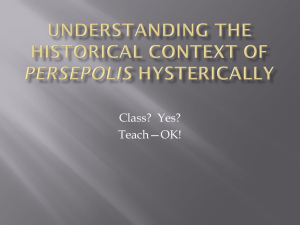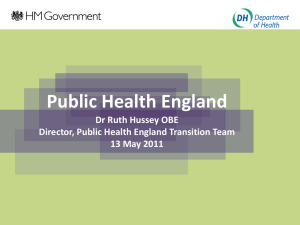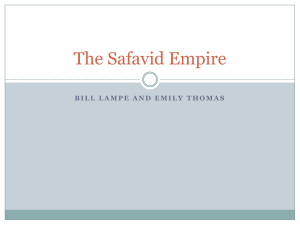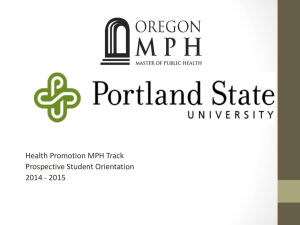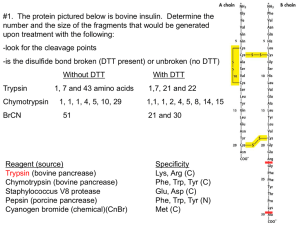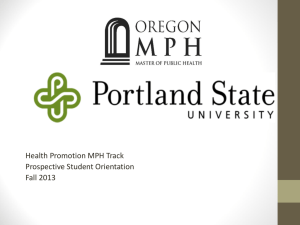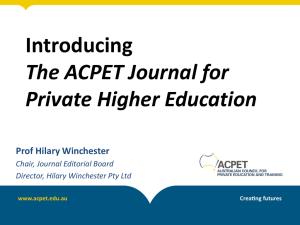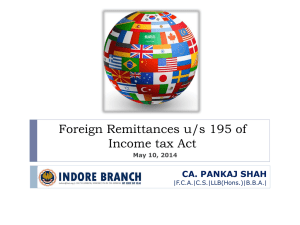Study Connections & University of Newcastle
advertisement
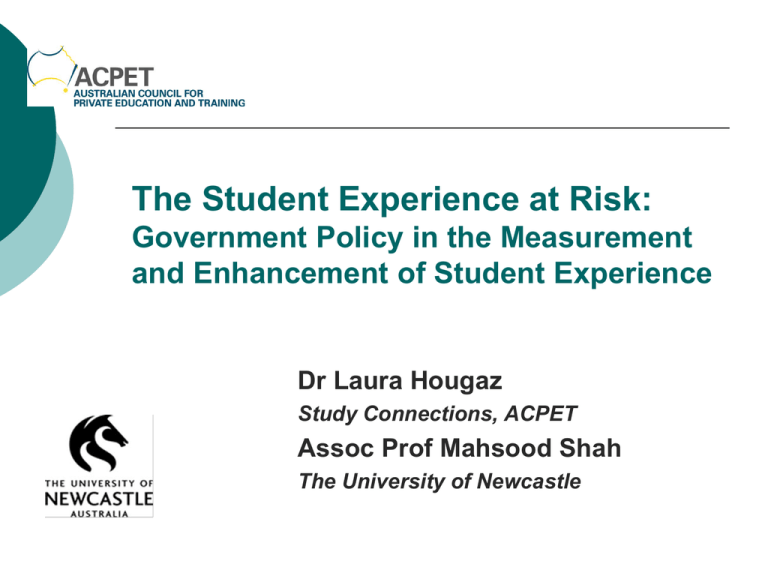
The Student Experience at Risk: Government Policy in the Measurement and Enhancement of Student Experience Dr Laura Hougaz Study Connections, ACPET Assoc Prof Mahsood Shah The University of Newcastle The Context: Enhancing quality in HE In recent years the Australian HE sector has come under pressure to demonstrate quality outcomes Efforts made to improve teaching through professional development, scholarship and research, and evaluation Review of policies and practices with focus on enhancing learning and teaching – ‘quality of teaching’ evaluation has refocused on ‘quality of student experience’ evaluation. Increased focus on student evaluations/feedback. Topic at glance Student experience matters Measurement of student experience in private higher education (PHE) Factors influencing student choice in PHE Research on student experience in PHE Government policies on the measurement of student experience Why is student experience at risk? Way forward 3 Student experience matters Prominence of student voice Student experience is used to assess teaching quality • Students’ perceptions are important parameters of the social and psychological aspects of the learning environment Student experience is used to assess the level of risk Global trend in the use of student feedback to: • develop and renew courses • review of courses • assessment of teaching and course quality • assessment of support services. 4 Student experience matters Data is increasingly used in rankings and marketing Data is used on MyUniversity website, Unistats Benchmarking performance of institutions Used in academic staff performance reviews and promotions Increased diversity of students, thus different expectations and experience Low satisfaction may cause attrition (quitting or transferring) Student complaints can harm reputation of institution We can only improve, if we listen and act on feedback. 5 Measurement of student experience in PHE Australian Graduate Survey (AGS): used by handful of PHE Internal semester based unit and teacher evaluation surveys are patchy across providers No standard instrument used to measure total student experience in PHE National Vet Regulator (NVR) learner engagement survey is used for compliance purpose only, rather than enhancement Use of data and closing the loop is an area where limited work is being done Ethical issues on data collection Lack of triangulation of survey data (qualitative /quantitative) along with other academic outcomes measures 6 Factors influencing student choice Student Perception Reputation Access and opportunity Pathway to university Word of mouth Transfer from University to private college due to referral Stepping stone in tertiary education Learning environment Small class size Personalised environment Ease of entry Completing degree via pathway Input Teachers from industry Course design Duration Student profile (mature age in some colleges) Graduate Success Success of graduates Practical nature Easy accessibility Work experience Online learning Location Teachers One to one interaction with teacher Doing well in industry Flexibility Specialised course relevant to professions Hands on experience Processes Outcomes Source: Shah, Nair, and Bennett. (2013). 7 Research on student experience in PHE Source: Nair, Bennett, and Shah, M. (2012). 8 Government policies: Measurement of student experience Bradley Review of Australian Higher Education (2008) concluded that a comprehensive set of measures of the quality of teaching and learning should be developed. These should include measures of the student experience and form part of a broader accountability framework focused on the achievement of outcomes. Recommendation 7 “That the Australian Government require all accredited higher education providers to administer the Graduate Destination Survey, Course Experience Questionnaire and the Australasian Survey of Student Engagement from 2009 and report annually on the findings.” (Bradley Review, 2008, Ch 3.4) Government policies: Measurement of student experience More focussed on universities AGS only used in universities, with lack of implementation in PHE New University Experience Survey (UES) only used in universities (domestic and onshore U/G) Development of UES did not involve PHE consultation Defeats the idea of “One Tertiary Education” No standard tool to measure offshore student experience despite being rated as high risk by TEQSA Lack of benchmarking of student experience No mechanism to ensure comparable experience 10 Why is student experience at risk? Lack of standard measurement tools used across the HE sector Data collection, coding, analysis and reporting is inconsistent Lack of benchmarking with all providers Absence of systematic process to identify areas needing improvement (at national and institutional level) OLT funding for research in learning and teaching does not support PHE Lack of student engagement in TEQSA assessments Closing the feedback loop – requires improvement The UK is further ahead in the developments in this area (Higher Education Academy, UK). 11 TEQSA and student experience Lack of innovation on how to determine if student experience is at risk Assessment of risk is based on paper trail review Huge reliance on institutional collected and analysed unit/teacher evaluation data – could be manipulated Current process to identify risk is based on data at overall institutional level No focus on assessing risk at course, faculty, campus level and partnership, online delivery mode No focus on assessing the experience of different cohorts of students (onshore/ offshore/ PG/ HDR, LSES, NESB etc) Lack of student engagement 12 Way forward Using standard tools such as AGS and UES Benchmarking student experience Need for a standard tool in PHE to measure student experience at teacher & subject levels Effective use of data in improving overall student experience Building capacity for design, collection, analysis and reporting of data Culture of closing the loop Use of qualitative data Build internal capacity for QA. 13 Recent publications related to PHE Shah, M., Nair, S., & Bennett, L. (2013). Factors Influencing Student Choice to Study at Private for-Profit Higher Education Institutions. Quality Assurance in Education, in press. Shah, M., & Nair, S. (2013). Private for–profit higher education in Australia: Widening Access and Participation and Opportunities for Public-Private Collaboration. Higher Education Research and Development (HERD), 32(5), 820-832. Shah, M., & Stanford, S. (2013). Quality and Regulation of Australian Tertiary Education: Searching for Sustainable QA Framework, The ACPET Journal for Private Higher Education, 2(1), 24-33. Shah, M., & Nair, S. (2012). Student Surveys and Feedback: Strategic Solution for all Tertiary Education Institutions. Studies in Learning, Evaluation Innovation and Development, 9(1), 74-83. Bennett, L., Nair, S., & Shah, M. (2012). The Emergence of Private Higher Education in Australia: The Silent Provider. European Journal of Higher Education, 2(4), 423-435. Nair, S., Bennett, L., and Shah, M. (2012). Student Experience in Private Higher Education in Australia. The ACPET Journal for Private Higher Education, 1(2), 24.30. Shah, M., & Nair, S. (2012). A New Dynamic in Australian Higher Education: The Emergence of Private for14 profit Higher Education. European Journal of Higher Education, 2(2-3), 307-317. Questions Dr Laura Hougaz studyconnections@gmail.com Laura.Hougaz@acpet.edu.au Assoc Prof Mahsood Shah mahsood.shah@newcastle.edu.au Thinking of doing PhD with focus on Private Higher Education ? Contact Assoc Prof Mahsood Shah, Newcastle University 15
